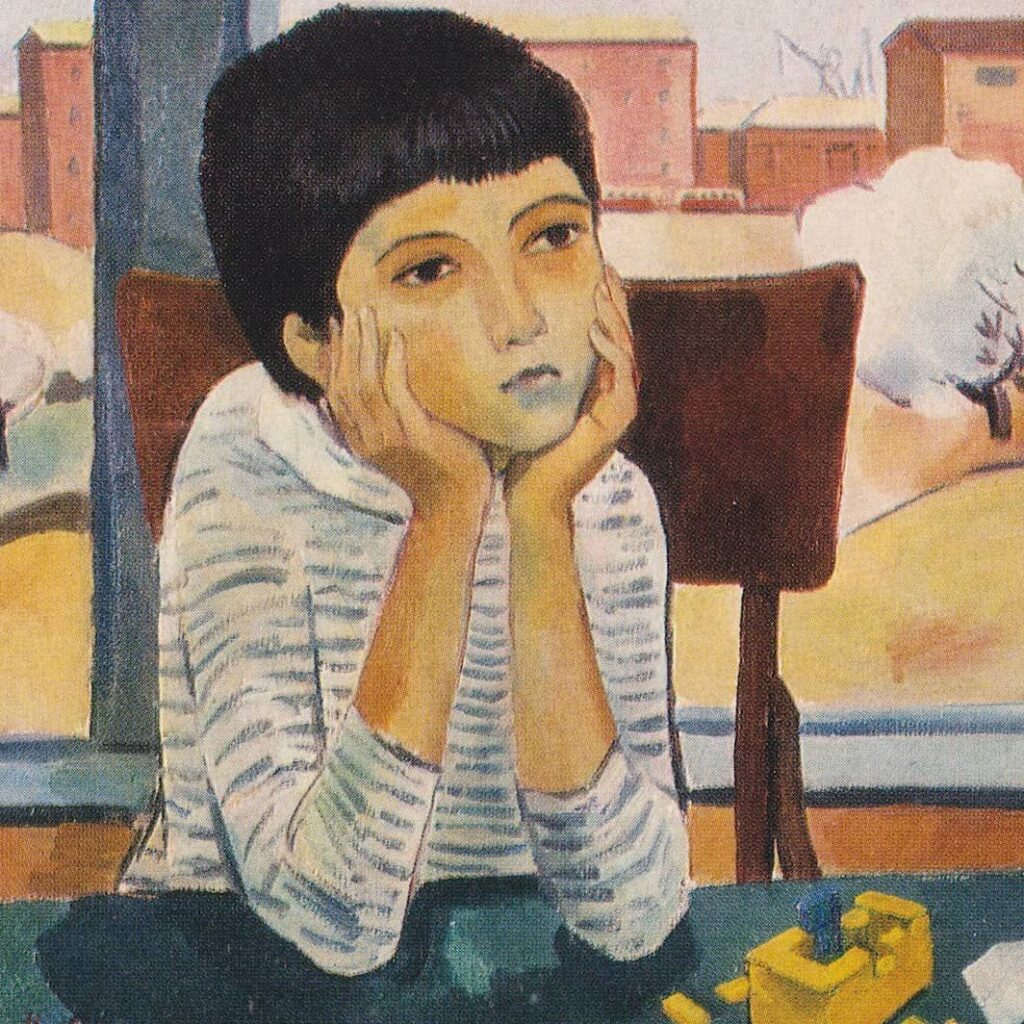My Name Is Aram
William Saroyan
1940
(An open and curious boy growing up in an Armenian community in California encounters the rich quirkiness of his family and neighbors.)

Writing from the spirit of memory. Not a record of specific memories, but effortless intuitive writing that naturally conjures the ethos, tinged with wistfulness, that can accompany the distant remembrance of simpler times. This was the inspiration of William Saroyan as he sat down, and boom, suddenly there appears what would become his best loved book of stories. With all the intense effort I put into my other books, this one (I’m imagining he thought), the one that practically wrote itself, the one in which I warned readers that nothing extraordinary would happen, this is the one?! In his own incredulous (or perhaps disingenuous) words, he “does not believe this manner of writing is the way to get a message to go high-rolling down the ages”. Its greatest value, he thought (not without satire), would be to disqualify him for membership in prestigious literary societies. One can understand why he was thinking this way. In the second half of the 1930s, having risen to the top of the charts, so to speak, with his debut collection of stories including “The Daring Young Man on the Flying Trapeze”, all eyes were on William Saroyan. Surrounded by the effervescing produce of Hemingway, Steinbeck, Faulkner, Fitzgerald, the pressure was on Saroyan to be likewise that great writer. And he did have such ambitions for himself. Yet, something drove him when starting My Name Is Aram to leave society’s gauntlet where it was thrown… or else maybe to find a different way to pick it up. My hunch (with hardly any evidence to back it up) is that he looked at this literary world he had entered, and decided that one helpful thing he could do right away is to center or root himself—to ask himself what had been important in making him who he is. Then, to search that out, or to convey it, he sat back and reminisced (pen in hand) about his humble early life in the immigrant Armenian fruit-growing community of the San Joaquin Valley, California. His goal was not to expose the suffering of the poor or rail eloquently against social ills, not to decry materialism or the threat of fascism, not to create a work of stylistic genious. Rather, his goal was simply to paint vignettes of the sorts of characters that were his family and neighbors in pre-Depression Fresno—to smile at them, to paint them in a sympathetic light, and to draw gently from them what practical wisdom and wit influenced his own development and might be worth preserving for others. Thus we have the young Aram Garoghlanian. And as the author says of himself, though he might not be Aram, he is certainly not not Aram.
The Dream of the Rood
anonymous (Anglo-Saxon)
7th-8th century
(In a vision, the cross of Christ reflects with awe on its part in the death of God.)

“The most beautiful of the medieval religious poems”. This is often said of The Dream of the Rood. The first time I read this assessment—I had never even heard of the poem—it was by the Anglo-Saxon scholar R. K. Gordon in the colorful old Everyman Library series. The description as beautiful captured my attention. And it is beautiful. The vivid imagery, the incorporation of heroic and mystical themes, the profound devotion, the ethereal vision, the very language. Seeing such a work called beautiful is gratifying, for it highlights a virtue that is often languishing in recent religious literature, and religious sensibility in general. In both East and West, the enjoyment of beauty has frequently been marred by a suspicion that it may tempt one to elevate the lower over the higher, or to submit to illusory or distracting pleasure. Calling a religious poem “beautiful” recalls a time and a place when beauty was a central value in the building of churches, in the composition of sacred music, in devotional images and writings, and even in the grounds for the faith commitment itself. There have been times and places when the contemplation and enjoyment of beauty was widely embraced, on the idea, as Aristotle said, that “Beauty is the gift of God.”
The Time Machine
H. G. Wells
1895
(A push on a lever, a blurry dizziness, a clap of thunder… and a veil falls away to reveal the world of our far distant descendants.)

Breaking the rule that you have to proceed constantly forward in time at precisely one second per second is as old as the human imagination, appearing even in ancient stories where a god or a bonk on the head could slip you to another point in history. Surprisingly enough, though, the idea of a device or vessel that can carry one through time in the way that wagons and boats carry us through space is apparently less than a century and a half old. Perhaps the backwards-running clock in an 1881 Edward Page Mitchell story is the first time machine in literature; or else, if you have to be able to climb into the thing for it to count, then Enrique Gaspar’s “anacronópete” of his now little-known 1887 novel of that name narrowly beats out H. G. Wells’ 1888 story “The Chronic Argonauts”. Evidently the hyperindustrializing and engine-happy Americans and Western Europeans of the late 19th century, inspired no doubt also by the first stirrings of modern physics, were beginning to let their minds wander as to what a precisely engineered assemblage of gears and rods and bolts might be able to do. The Time Machine is the quintessence of this concept in literature, and is one of the best science fiction stories we have, even given the golden age of that genre that followed.
The Honorary Consul
Graham Greene
1973
(Argentinian revolutionaries abduct the wrong political figure by mistake, and one cynical acquaintance is the only one who cares… perhaps not even he does.)

Graham Greene, though a writer of great variety, is known for his “seedy” settings (he popularized the adjective, much to his regret) and the moral dimension of his very human characters. In these respects The Honorary Consul is an enduring and typical example of Greene’s style. Early in the book the protagonist Eduardo Plarr criticizes the romantic novelist Saavedra by saying that “life isn’t like” the way that author writes. Here Greene crafts a novel according to the alternative strategy; to show what life is like, with real people encountering real difficulties. The characters’ frail humanity and the ambivalence of their commitments will encourage us imperfect readers to relate honestly to them. The author refuses to vault skyward into heroism, idealism, wonder, or joy, perhaps as these are short-lived and usually confused in the real world. The good guys are bad enough to prevent us from admiring them, and the bad guys are good enough to prevent us from demonizing them. No character has an entirely appetizing mixture of traits, but no character is thoroughly distasteful either.
Like many readers, my gut draws me towards works whose moral distinctions rise into sharper relief—I enjoy esteeming my protagonists. If we insist on this criterion, Greene will not fare well. After meeting the main characters and following them around for a while, we might question whether they are likable enough company. Such readers must take a step of faith throughout the first 100 pages or so, that Greene is telling us a story that we will really care to read. Embarking on the book was for me like hearing the first few sentences of a party yarn that we fear might not be worth the patience. However, may no reader give up before realizing Greene’s purpose! The first impression fades and becomes irrelevant as one reads onward. The grayscale characterization is not due to neglect or apathy on the part of the author. Far from it—the ambiguity represents a strategy conceived for a distinct moral purpose, as paradoxical as this seems. A novel need not be moralizing to be morally interesting. (more…)



Madame Bovary
October 21, 2020 / Leave a comment
Gustave Flaubert
1857
(An unhappily married woman pursues a lifelong quest for the fulfillment of her romantic desires, by any means necessary.)
When a novelist is said to rebel against romanticism, anyone with an imaginative, adventurous, passionate, chivalrous, or spiritual streak may be forgiven for wanting to give it a pass. Such a writer sounds staid and dry, shaking a finger at anything beautiful or enjoyable; or worse, morose—seeing the gray in everything and anxious to spend hundreds of pages sharing it with you. So who is this Flaubert, then? Flaubert with the beautiful descriptions, the engaging plot, the dramatic scenes, the fevered dialogue? With this great author’s help we should make a crucial distinction. Flaubert’s aim is leveled not at imagination or adventure or passion or chivalry or spirituality per se, but rather at the perverse attention romantics often pay to the emotional effects that these things have on us. Just as it is not money itself, despite frequent misquotes, but the love of money, that is said to be the root of all sorts of evil, likewise it is the worship of imagination’s fancy-tickling effects, rather than imagination itself, that novels like Madame Bovary seek to dethrone. Emma Bovary ruins her life because, in Flaubert’s words, she seeks emotions, not landscapes. She has a sentimental rather than artistic temperament, meaning she wants to gobble up beauty rather than appreciate it. The romanticism Flaubert criticizes is selfish, subjective, emotivist. It is that attitude which confuses sensual appeals of luxury with the joys of the heart. It is what says “Give me that” rather than “That is wonderful”. Even a true romantic, a healthy romantic– perhaps especially such a person– can doff the hat to Flaubert for this.
(more…)